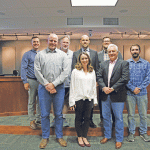Town board focused on water
The town’s water consultant, Leonard Rice Engineers Inc. (LRE) along with coordination from town staff and Berthoud’s water attorney, Paul Zillis of Vranesh and Raisch LLP, have finalized an update to the town’s 2020 Water Resources Master Plan. Zillis gave an overview of Colorado water law along with a summary of the town’s current water rights. He noted that Berthoud holds the most senior water rights on the Big Thompson River.
Andrew Case of LRE gave a summary of the findings of the Master Plan Update.
A summary of the results from Leonard Rice Engineers on the updated 2020 Master Plan are as follows:
Berthoud should be able to meet its build-out demands 2,860 Acre Feet (AF) potable and 1,950 AF non-potable, under projected climate change conditions, by closing on its five additional Windy Gap Units for a total of eight Windy Gap Units; acquiring and/or developing new storage or the right to store water in existing reservoirs to regulate and increase the yield of the town water supplies; maximizing its reuse capabilities by using fully consumable effluent to augment a new junior water right; acquiring a controlling number of shares in the Loveland Lake and Ditch Company (LLDC) to allow Berthoud to store alternate supplies there; and by acquiring and changing Handy Ditch (46.83 total shares [452 AF/year]) and LLDC (150 total shares [446 AF/year]) shares in Water Court.
It was recommended the town should pursue a program of using non-potable water for irrigating whenever practical to do so. Berthoud would gain an extraordinary amount of flexibility for serving non-potable irrigation demands by acquiring additional LLDC shares for storage and control of the company to ensure the ability to operate its capacity in Loveland Lake independently to allow the storage of C-BT Units and other supplies in the reservoir. In that event, Lake Loveland could also be used to firm a portion of Berthoud’s Windy Gap Units. This would free up space in Berthoud Reservoir for potable supplies such as changed water rights and diversions from the Little Thompson River. The benefit of changing LLDC shares to municipal uses is more limited than Windy Gap Units due to return flow obligations, which require additional storage to cover periods when Berthoud cannot claim WWTP effluent because C-BT Units were delivered through Berthoud’s municipal system.
The town should develop the ability to reuse its fully consumable water supplies to extinction, by diverting water from the Little Thompson River with junior water rights and augmenting those diversions with the fully consumable portion of Berthoud’s wastewater treatment plant (WWTP) effluent. Currently, Berthoud may only reuse changed Handy Ditch Company shares and Windy Gap supplies, but the ability to reuse those supplies provides the most impact on the number of potable taps that Berthoud can serve. Storing Windy Gap reuse is the only way for Berthoud to firm its Windy Gap Units, and any remaining reuse is available for augmentation and replacement.
Berthoud’s existing Windy Gap Units provide a significant amount of potable water supplies once reuse is possible. To the extent that Berthoud wishes to expand the maximum number of potable taps that could be served, the acquisition of additional Windy Gap Units, especially if firmed, would be the most effective way to do that when compared to the acquisition and change of Handy Ditch Company or LLDC shares.
The items above are but a small fraction of the information presented in the Water Resources Master Plan. The full text and supporting information may be viewed on the town’s website.
- March, 15 2018

Oprah can’t resurrect “A ...
By Aaron Reynolds The Surveyor 2.5 stars out of 5 Once upon a time Disney...
- April, 27 2017

Familiar face returning to coach Bert...
By Dan Karpiel The Surveyor Whoever it was that...
- July, 06 2017

Larimer Humane Society: PETS OF THE WEEK
Courtesy of the Larimer Humane Society Meet this week's Pets of the Week, Fraggle a...
- July, 03 2018

Stage I Fire Restrictions put in plac...
By Amber McIver-Traywick The Surveyor Larimer County is currently in Stage 1 Fire Restrictions as...
- June, 16 2022

Town Board to allow limited applicati...
At the regular meeting of the Berthoud Board of Trustees on Tuesday evening, the board...
- June, 09 2016

Berthoud Day competition brings out l...
Taytlin Harrigfeld and RaeAnn Fooks competed in the Berthoud’s Got Talent...

Berthoud mulls Downtown Development Authority
Community News
Berthoud takes second in R2J Girls Invitational
Community News
A day in the life as Berthoud’s top cop
Community News
Unified basketball comes to Turner Middle School
Community News

Mike Grace says goodbye as Brett Wing joins town board
Community News
POLICEBLOTTER
Community News
Northern Water sets C-BT quota at 70% for 2024
Community News

Emotions run high during Revere Property hearing
Community News
COMMUNITY CALENDAR:
Community Calendar – add an event
Homestead Fine Art Gallery First Fridays OPEN HOUSE
07 Jun 4:00 PM - 7:00 PM
Homestead Fine Art Gallery First Fridays OPEN HOUSE
05 Jul 4:00 PM - 7:00 PM
Homestead Fine Art Gallery First Fridays OPEN HOUSE
02 Aug 4:00 PM - 7:00 PM
Homestead Fine Art Gallery First Fridays OPEN HOUSE
06 Sep 4:00 PM - 7:00 PM
Homestead Fine Art Gallery First Fridays OPEN HOUSE
04 Oct 4:00 PM - 7:00 PM
Homestead Fine Art Gallery First Fridays OPEN HOUSE
01 Nov 4:00 PM - 7:00 PM





